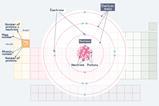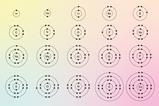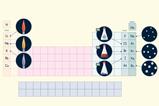Education research inspired me to improve my scheme of work for structure and bonding

I believe education research is very valuable for informing teaching and learning, but only once applied in context by teachers. Lack of time, access to literature and readability of research are barriers to applying research for many practitioners. But open-access sources, educational research organisations and social media networks are helping to bridge the gap between research and application.
When I was tasked with writing a scheme of work for key stage 4 structure and bonding, I took the opportunity to apply knowledge I’d picked up from education research and test its benefits. I found inspiration for designing the work from reading literature around threshold concepts, bottlenecks and spaced practice.
I used studies of chemical misconceptions to identify common stumbling blocks for students learning about structure and bonding.
To determine which misconceptions my students held, I set conceptual questions for homework with in-built confidence measures. Students could indicate how confident they were about their answers. Combining their responses and confidence scores allowed me to order the concepts by relative difficulty.
Tricky concepts
It became apparent that ionic bonding and structure encompassed a number of particularly problematic key concepts. This may be because the topic is often introduced using dot and cross diagrams, which can give students a picture of ionic molecules with a localised charge located in the top right hand corner of each ion.
I found three concepts were particular bottlenecks that prevented students’ progress.
The first of these is the concept that particles in solids and liquids are held together by forces; the amount of energy required to overcome them depends on their relative strength. This is a universal underlying concept for all structures in the key stage 4 curriculum. I wasn’t surprised it cropped up as a bottleneck here.
The reading and research I carried out for this topic really deepened my understanding of pedagogy and strengthened my teaching
Secondly, students needed to understand that ions within an ionic compound remain as ions, whatever their physical state. They found this counter-intuitive – I had to keep reinforcing the idea. But this is key to understanding how and why ionic compounds can conduct electricity when molten or in aqueous solution.
Overcoming this bottleneck helps when teaching electrical conductivity and electrolysis. To help illustrate how ions retain their character, even in aqueous solution, I demonstrated a simple precipitation reaction: combining two colourless solutions, a brightly coloured precipitate forms as ions from the first solution combine with oppositely charged ions from the second one.
Thirdly, the fact that many millions of ions are involved in reactions to form ionic compounds, not just the few represented by dot and cross diagrams. This was unexpected as it seems straightforward. But many students pictured individual ions – as in dot and cross diagrams – rather than the multitudes of atoms and ions involved in any reaction.
If I reminded them about this idea, I would often see visible lightbulb moments.
Improving understanding
Taking all this into account, I now emphasise the following points when introducing ionic bonding to students:
- Ion charges arise from an imbalance between positive and negative particles. Transferred electrons don’t leave a hole or plug a gap.
- Charge is distributed throughout the ion, denoted by square brackets.
- Electrons transfer between individual atoms, but once formed, ions will be attracted to any oppositely charged ion, and in all directions, rather than forming discrete bonds.
- Reactions involve millions (billions!) of ions, so ionic formulas represent a ratio, not the total number of ions within a unit.
I read about the value of spaced practice to improve retention (pdf). So I taught these concepts explicitly, then reviewed them periodically. The liminal nature of learning (pdf) – the need for learners to let go of misconceptions in order to learn correct concepts – can tempt students to resort to mimicry instead of developing true understanding. I felt spaced practice would allow students the time and space to change their views and build understanding.
The reading and research I carried out for this topic really deepened my understanding of pedagogy and strengthened my teaching. It certainly benefited the students I teach.









![Education research shutterstock 139305425 300tb[1]](https://d1ymz67w5raq8g.cloudfront.net/Pictures/100x67/5/6/4/113564_educationresearch_shutterstock_139305425_300tb1.jpg)




No comments yet